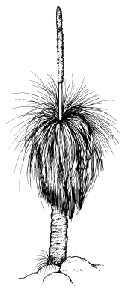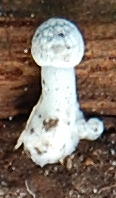
Since we have moved onto a quarter-acre block in town, of course we do not have the variety of native animals and plants that we had when we lived on the farm. But the native garden we are working on at the front of the house does attract some birds and there are a few other animals living in our backyard and in the patio and the pond.
Bird list: farm
The following list is restricted to birds actually seen by us on our farm:
- Purple-crowned Lorikeet (Glossopsitta porphyrocephala)
- Western Rosella (Platycercus icterotis)
- Ring-necked ("Twenty-eight") Parrot (Platycercus zonarius semitorquatus)
- Red-capped Parrot (Platycercus spurius)
- Elegant Parrot (Neophema elegans)
- Galah (Cacatua roseicapilla)
- Baudin's Cockatoo (Calyptorhynchus baudinii)
- Red-tailed Black Cockatoo (Calyptorhynchus magnificus)
- Magpie-lark (Grallina cyanoleuca)
- Grey Butcherbird (Cracticus torquatus)
- Australian Magpie (Cracticus tibicen)
- Australian Raven (Corvus coronoides)
- Welcome Swallow (Hirundo nigricans)
- Black-faced Cuckoo-shrike (Coracina novaehollandiae)
- Golden Whistler (Pachycephala pectoralis)
- Grey Fantail (Rhipidura fuliginosa)
- Willie Wagtail (Rhipidura leucophrys)
- Splendid Fairy Wren (Malurus splendens)
- Red-winged Fairy Wren (Malurus elegans)
- Yellow-rumped Thornbill (Acanthiza chrysorrhoa)
- Scarlet Robin (Petroica multicolor)
- Red-eared Firetail Finch (Emblema oculatum)
- White-browed Scrub-wren (Sericornis frontalis)
- Grey-breasted White-eye (Zosterops lateralis)
- Brown Honeyeater (Lichmera indistincta)
- Singing Honeyeater (Meliphaga virescens)
- New Holland Honeyeater (Phylidonyris novahollandiae)
- Red Wattlebird (Anthochaera carunculata)
- Western Spinebill (Acanthorhynchus superciliosus)
- Grey Shrike-thrush (Colluricincia harmonica)
- Masked Woodswallow (Artamus personatus)
- Shining Bronze Cuckoo (Chrysococcyx lucidus)
- Barn Owl (Tyto alba)
- Southern Boobook (Mopoke) (Ninox boobook prev. Ninox novaeseelandiae)
- Laughing Kookaburra (Dacelo gigas)
- Sacred Kingfisher (Halcyon sancta)
- Wedgetailed Eagle (Aquila audax)
- Little Eagle (Aquilar morphnoides)
- Australian Kestrel (Falco cenchroides)
- Black-shouldered Kite (Elanus caeruleus)
- Brown Goshawk (Accipiter fasciatus)
- Black Duck (Anas superciliosa)
- Wood Duck (Chenonetta jubata)
- Mountain Duck (Tadorna tadornoides)
- Straw-necked Ibis (Threskiornis spinicollis)
- Sacred Ibis (Threskiornis aethiopicus)
- White-faced Heron (Ardea novaehollandiae)
- Pacific [White-necked] Heron (Ardea pacifica)
- Little Pied Cormorant (Phalacrocorax melanoleucos)
- Little Black Cormorant (Phalacrocorax sulcirostris)
- Yellow-billed Spoonbill (Platalea flavipes)
- Crested pigeon (Ocyphaps lophotes)
- Common Bronzewing (Phaps chalcoptera)
Bird list: in town
These are the birds we have seen at our house in Denmark:
- Ring-necked ("Twenty-eight") Parrot (Platycercus zonarius semitorquatus)
- Galah (Cacatua roseicapilla)
- Australian Magpie (Cracticus tibicen)
- Australian Raven (Corvus coronoides)
- Red-winged Fairy Wren (Malurus elegans)
- Yellow-rumped Thornbill (Acanthiza chrysorrhoa)
- Red-eared Firetail Finch (Emblema oculatum)
- Grey-breasted White-eye (Zosterops lateralis)
- New Holland Honeyeater (Phylidonyris novahollandiae)
- Red Wattlebird (Anthochaera carunculata)
- Western Spinebill (Acanthorhynchus superciliosus)
- Laughing Kookaburra (Dacelo gigas)
- Crested pigeon (Ocyphaps lophotes)
- Common Bronzewing (Phaps chalcoptera)
- Silver Gull (Larus novaehollandiae)
Authority: Storr, G.M. and Johnstone, R.E. (1985) A Field Guide to the Birds of Western Australia. Second Edition. Published by the Western Australian Museum.
Experience has taught us that some of the colour rendition in some of the photos in this book are far from realistic (maybe preserved specimens were used, or just poor printing?) so we have learnt to check sightings in "A Field Guide to Australian Birds" by Peter Slater, which seems to have much more accurate colours.
The following list is restricted to frogs found by us on our farm:
- Western bell frog or motorbike frog (Litoria moorei )
- Slender tree frog (Litoria adelaidensis )
- Moaning frog (Helioporus eyrei )
- Bleating froglet (Crinea pseudinsignifera )
- Quacking frog (Crinea georgiana )
- Banjo frog (Limnodynastes dorsalis)
- Western bell frog or motorbike frog (Litoria moorei )
- Slender tree frog (Litoria adelaidensis )
- Quacking frog (Crinea georgiana )
Authority: Tyler, M.J. et.al. (2000) Frogs of Western Australia . Third Edition. Published by the Western Australian Museum.
We have the newly-revised edition of this book which was first published in 1984. Some West Australian frogs can be more difficult to identify than you might think. In particular members of the Crinea genus of small frogs can be very variable, but members of different species can look very similar. In fact Tyler, et. al. suggest that C. insignifera and C. pseudinsignifera are indistiguishable in external morphology, only being told apart in the field by their calls, and that a hybrid zone exists where their ranges overlap on the lower west coast. Our identification relies on the farm being outside the range of one of the species. And yes - it is noisy with all that quacking, bleating, motorbike gear changing and moaning going on!
The dams and the pond attracted quite a number of dragonflies and damselflies. The little handbook which we have to identify them is quite old now, but still may be the definitive reference. Our list is limited because without a microscope it is very difficult to see some of the features required to identify dragonflies (and in adition most of them are not easy to catch). There do not appear to be any common names for these insects.
- Orthetrum caledonicum
Authority: Watson, J.A.L. (1962) The Dragonflies (Odonata) of South-Western Australia. Handbook no. 7. Published by the Western Australian Naturalists Club, Perth.
We found one amazing damselfly (which we could not identify, but it appears to be common) on the farm, laying its eggs on the wooden "piles" of our small jetty in the dam. This does not sound so strange, except the female is totally immersed three to five centimetres under the water, and stays there for at least five or ten minutes while she grasps the wood and lays her eggs. When she is finished she appears to leave the water still well and truly alive.

Farm plant list
 This list only includes native plants growing on our farm, and represents just a small fraction of its complete flora. Our 17 hectares (43 acres) had a very limited selection of the plants of the surrounding region, since sheep have had free access to the uncleared areas for many years, and the farm represents a small and rather uniform sample of the surrounding countryside.
This list only includes native plants growing on our farm, and represents just a small fraction of its complete flora. Our 17 hectares (43 acres) had a very limited selection of the plants of the surrounding region, since sheep have had free access to the uncleared areas for many years, and the farm represents a small and rather uniform sample of the surrounding countryside.
There are lots of introduced species, including eastern states eucalypts, pasture plants, garden plants and weeds.
We have difficulty accurately identifying all but the most common and well-known of our native plants. We only have volumes one and four of the authoritative reference (Blackall, W.E. and Grieve, B.J. (1988) How to know Western Australian Wildflowers 2nd Edition, published by University of Western Australia Press) which covers only the southern half of the state but still needs four volumes just for the Dicotyledons, with another for the Monocotyledons and ferns. On a world scale the southwest of Western Australia has an extremely high floral diversity (around 10 000 species of flowering plants), with many bizzare specimens including an orchid which grows and flowers entirely underground (very few specimens have ever been found!).
- Red and Green Kangaroo Paw (Anigozanthos manglesii)
- Xanthorrhoea (Xanthorrhoea preissii)
- Grass Tree (Kingia australis)
- Fringed Lily (Thysanotus sp.)
- Western Australian Christmas Tree (Nuytsia floribunda)
- Bull Banksia (Banksia grandis)
- Marri (Eucalyptus calophylla)
- Albany Blackbutt (Eucalyptus staeri)
- Book Trigger Plant (Stylidium calcaratum)
- Native Iris (Patersonia sp.)
- Australian Broom-Rape (Orobanche australiana)
- Burchardia (Burchardia sp.)
- Bluegrass Lily (Agrostocinium sp.)
- Blue Squill (Chamaescilla sp.)
- Sundew (Drosera sp.)
- Comsperma (Comsperma sp.)
- Pimelea (Pimelea sp.)
- Ti Tree (Leptospermum sp.)
- Wattle (Acacia sp.)
- Hovea
- Sun orchid

Fungi list
 After moving to the farm we became interested in the local fungi. Youngs Siding seems to be a good area for them, and the farm had many different mushrooms, wood fungi, toadstools, puffballs and other examples of these organisms.
After moving to the farm we became interested in the local fungi. Youngs Siding seems to be a good area for them, and the farm had many different mushrooms, wood fungi, toadstools, puffballs and other examples of these organisms.
Fungi are notoriously difficult to identify; currently we are referring to Neale L. Bougher and Katrina Syme Fungi of Southern Australia, as well as Neale L. Bougher Perth Urban Bushland Fungi Field Book. We also use Patricia Negus The Magical World of Fungi to aid with initial visual identification, and Fungi Down Under, the Fungimap guide.
Over the years we collected pictures of the fungi on our farm and tried to identify them, but remember that any idenfication made on our web site is just our best guess!
- Scarlet Bracket Fungus (Pycnoporus coccineus)
- Earthballs (Scleroderma sp.)
- White Punk (Laetiporus portentosus)
- Shy Funnel Cap (Clitocybe semiocculta)
- Tennis Ball Puffball (Mycenastrum corium)
- Dog Poo Fungus (Pisolithus sp.)
- Woody Layered Bracket Fungus (Phellinus robustus)
- Impatient Ink Cap (Coprinus impatiens)
- Hairy Sterum (Stereum hirsutum)
- Black Jelly Fungus (Exidia sp.?)
- Bolete
- Bolete Eater

Mosses and Lichens
 While photographing fungi we noticed a wonderful selection of lichens, and mats of mosses.
While photographing fungi we noticed a wonderful selection of lichens, and mats of mosses.
This collection of pictures of moss and lichen on our farm is just to celebrate their existence. A number of the photographs are of the same species, showing more or different detail.

